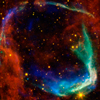CXC Home | Search | Help | Image Use Policy | Latest Images | Privacy | Accessibility | Glossary | Q&A
Tour of RCW 86
Quicktime MPEG
In 185 A.D., Chinese astronomers noted a "guest star" that mysteriously appeared in the sky and stayed for about 8 months. By the 1960s, scientists had determined that the mysterious object was, in fact, a supernova. Later, they figured out that this supernova remnant, now known as RCW 86, was located about 8,000 light years away. Today, astronomers have taken data from four different telescopes to make this stunning new image of RCW 86. Here, X-rays from Chandra and XMM-Newton have been combined with infrared data from the Spitzer Space Telescope and the WISE mission. Taken together, these data show that the explosion from nearly 2,000 years ago was caused by a so-called Type Ia supernova. This type of supernova happens when a white dwarf star pulls too much material from a companion star, causing a thermonuclear explosion to go off.
[Runtime: 01:14]
Quicktime MPEG
In 185 A.D., Chinese astronomers noted a "guest star" that mysteriously appeared in the sky and stayed for about 8 months. By the 1960s, scientists had determined that the mysterious object was, in fact, a supernova. Later, they figured out that this supernova remnant, now known as RCW 86, was located about 8,000 light years away. Today, astronomers have taken data from four different telescopes to make this stunning new image of RCW 86. Here, X-rays from Chandra and XMM-Newton have been combined with infrared data from the Spitzer Space Telescope and the WISE mission. Taken together, these data show that the explosion from nearly 2,000 years ago was caused by a so-called Type Ia supernova. This type of supernova happens when a white dwarf star pulls too much material from a companion star, causing a thermonuclear explosion to go off.
[Runtime: 01:14]
(Credit: NASA/CXC/A. Hobart)
Return to RCW 86 (October 26, 2011)



